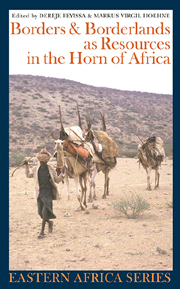Book contents
- Frontmatter
- Contents
- List of Maps, Tables & Charts
- Preface by Günther Schlee
- Editors' Preface
- Notes on Contributors
- List of Acronyms
- 1 State Borders & Borderlands as Resources
- 2 More State than the State?
- 3 Making Use of Kin beyond the International Border
- 4 The Tigrinnya-speakers across the Borders
- 5 Trans-Border Political Alliance in the Horn of Africa
- 6 People & Politics along & across the Somaliland-Puntland Border
- 7 The Ethiopian-British Somaliland Boundary
- 8 The Opportunistic Economies of the Kenya-Somali Borderland in Historical Perspective
- 9 Magendo & Survivalism
- 10 Can Boundaries not Border on One Another?
- 11 Conclusion
- Index
- EASTERN AFRICAN STUDIES
3 - Making Use of Kin beyond the International Border
Inter-ethnic Relations along the Ethio-Kenyan Border
Published online by Cambridge University Press: 05 April 2013
- Frontmatter
- Contents
- List of Maps, Tables & Charts
- Preface by Günther Schlee
- Editors' Preface
- Notes on Contributors
- List of Acronyms
- 1 State Borders & Borderlands as Resources
- 2 More State than the State?
- 3 Making Use of Kin beyond the International Border
- 4 The Tigrinnya-speakers across the Borders
- 5 Trans-Border Political Alliance in the Horn of Africa
- 6 People & Politics along & across the Somaliland-Puntland Border
- 7 The Ethiopian-British Somaliland Boundary
- 8 The Opportunistic Economies of the Kenya-Somali Borderland in Historical Perspective
- 9 Magendo & Survivalism
- 10 Can Boundaries not Border on One Another?
- 11 Conclusion
- Index
- EASTERN AFRICAN STUDIES
Summary
Introduction
International borders, particularly those in Africa, have been perceived as constraints to the livelihoods of the people divided by them (see Chapter 1 by Dereje and Hoehne in this volume). Gufu Oba (2000) has succinctly explained how the Borana Oromo who were divided by the colonial border between the two empires, Ethiopia and Great Britain, suffered enormously at various times. He elucidated in particular the agony of the Obbu Borana who reside along the Kenyan-Ethiopian border, mainly because of the closure of access to water sources on the Ethiopian side which is highland and rich in water resources. The problem of the Obbu Borana climaxed during the Italian occupation.
Without deeming this perspective unimportant, this chapter explains the advantages of the same borders, but in post-colonial times. I shall try to explain how individuals and groups instrumentalize the border at present as a resource in order to win the competition and conflict among themselves, on the one hand, and between themselves and the states to which they ‘belong’, on the other. I start by briefly introducing the three communities which serve as a case study to substantiate the argument.
The Borana are predominantly cattle pastoralists. They inhabit the southern rangelands straddling the Ethio-Kenyan border. In Ethiopia they live in the Borana and part of the Guji Zones of the Oromia National Regional State. In Kenya their home areas are the districts of Moyale, Isiolo and Marsabit. Ethnically, the Borana are one of the groups that make up the Oromo nation.
- Type
- Chapter
- Information
- Publisher: Boydell & BrewerPrint publication year: 2010

